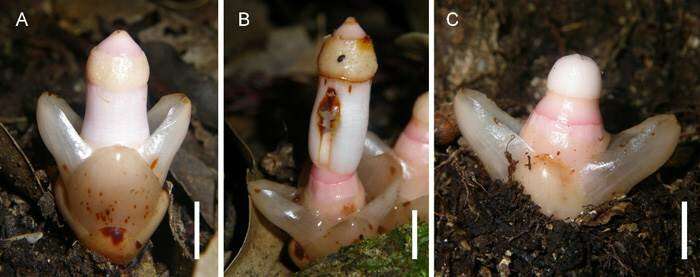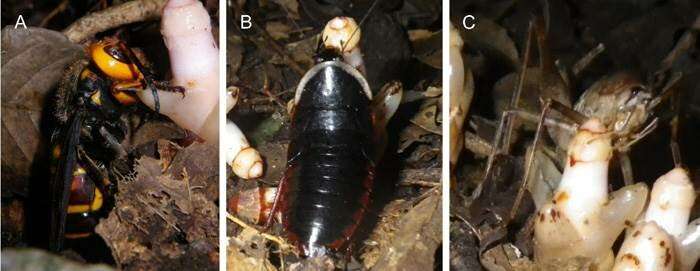Wasps, cockroaches and crickets are pollinators too

Wasps, cockroaches and crickets are widely disliked, but for a certain species of plant on the Japanese island of Yakushima they play a vital role. While studying the non-photosynthetic Mitrastemon yamamotoi plant, Associate Professor Kenji Suetsugu revealed that these insects were responsible for its pollination. Suetsugu is a member of the Kobe University Graduate School of Science, and these findings were published in the January 2019 edition of Plant Biology.
Mitrastemon yamamotoi grows on the dark forest floor, an environment rarely visited by typical pollinators such as bees and butterflies. It also has unusually-shaped flowers that bloom just above ground. These characteristics mean that M. yamamotoi cannot use the more standard insect pollinators but must instead rely on a different group of creatures.
Actually, around 90% of flowering plants get help with cross-pollination from bees and other animals by providing rewards such as pollen and nectar. This symbiotic relationship supports the foundations of our ecosystem: among the 100 species of crops that make up 90% of the world's food resources, 70% use bees as pollinators.
While honeybees are undeniably important, some plants entrust their pollination to different animals. Several species of banana use bats, and the banksia plant relies on opossums. The relationship with pollinators has played a large role in plant diversification, so plants with odd-looking flowers may well be pollinated by an unusual type of animal.

Mitrastemon yamamotoi is a non-photosynthetic plant that paratisizes plants in the beech family such as Castanopsis sieboldii. This plant was first discovered in Japan's Kochi prefecture (figure 1). Because of its strange appearance, it was thought to be related to parasitic plants in the family Raffllesiaceae, but recent DNA analysis revealed that it belonged to Ericales. We already knew that birds such as Japanese White-eye visited M. yamamotoi, but until now there have been no studies that accurately revealed the most effective pollinators.
From 2008 to 2011, Associate Professor Suetsugu carried out observations, day and night, of the animals that visited M. yamamotoi in one of its native habitats of Yakushima. He found that floral visits from birds were surprisingly rare. Meanwhile, the most important pollinators were revealed to be wasps, cockroaches and camel crickets (figure 2). These insects bustle quickly from flower to flower in M. yamamotoi to suck its nectar, and fly away with large amounts of pollen on their bodies. Suetsugu confirmed that the flowers visited by these insects came to fruit in the following days.
Wasps, cockroaches and crickets are not generally seen as major pollinators. Cockroaches have only been recorded as pollinating a few species of plants throughout the world, and there was no record at all of plants pollinated by camel crickets until now. One explanation for this unusual choice of pollinators is M. yamamotoi's habitat. Plants that do not photosynthesize can live in environments where the sunlight barely reaches, giving them an edge over potential competitors. In these dark environments you rarely find the more common pollinating insects such as bees and butterflies. This is probably why the plant relies on wasps, which look for food in comparatively gloomy environments, as well as the cockroaches and crickets that roam the forest floor.
It is not clear exactly how M. yamamotoi attracts these insects, but wasps, cockroaches and crickets all enjoy fermented food such as tree sap, and the nectar of the M. yamamotoi flowers has a fermented odor for humans. "I believe that this fermentation smell may be the key to attracting the insects," says Suetsugu, "and I plan to discover the mechanism that M. yamamotoi uses to release this scent." He also adds: "The wasps, cockroaches and crickets revealed as the pollinators of M. yamamotoi are widely disliked by humans. Through this research, I hope to draw people's attention to the important role of these creatures in our ecosystem."
More information: K. Suetsugu et al. Social wasps, crickets and cockroaches contribute to pollination of the holoparasitic plant Mitrastemon yamamotoi (Mitrastemonaceae) in southern Japan, Plant Biology (2018). DOI: 10.1111/plb.12889
Provided by Kobe University




















